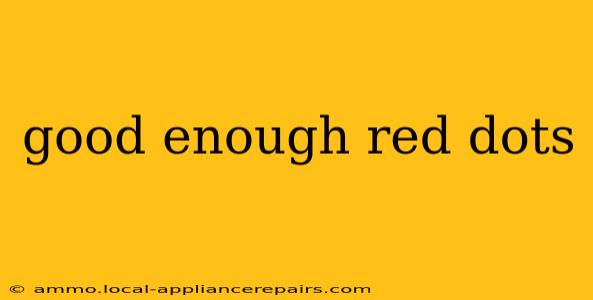Finding the "Good Enough" Red Dot: A Guide to Selecting the Right Red Dot Sight
Choosing a red dot sight can feel overwhelming. The market is flooded with options, each boasting features and price points that cater to various needs and budgets. This guide will help you navigate the choices and find the "good enough" red dot sight for your specific requirements. "Good enough" isn't about settling; it's about finding the optimal balance between performance, features, and price.
Understanding Your Needs: The Foundation of Selection
Before diving into specific models, honestly assess your needs. What will you primarily use the red dot for?
- Home Defense: Prioritize ease of use, reliability in low-light conditions, and a robust build. Speed and instinctive shooting are key here.
- Hunting: Durability, battery life, and clarity at longer ranges become more important. Consider the specific hunting environment and the distances involved.
- Competition: Weight, adjustability, and a crisp reticle are critical factors. Speed and precision are paramount.
- Tactical Applications: Robustness, reliability, and compatibility with night vision devices may be crucial.
Key Features to Consider:
-
Reticle Type: The simplest dot is often best for close-quarters work. More complex reticles, including circles, dots with circles, or even BDC reticles (ballistic drop compensators), cater to longer ranges or specific applications. Consider the reticle's impact on target acquisition speed versus precision at distance.
-
Battery Life: Battery life varies dramatically. Some use readily available CR2032 batteries, while others utilize more specialized options. Longer battery life is desirable, especially for extended use or in situations where battery changes are difficult.
-
Durability & Build Quality: A rugged, weather-resistant sight is essential for many applications. Consider the material (aluminum is common), the waterproofing rating (IPX7 is a good benchmark), and the overall construction.
-
Brightness Adjustment: The ability to adjust brightness is critical for diverse lighting conditions. Look for sights with a wide range of settings and multiple night vision compatible settings if needed.
-
Eye Relief: Eye relief is the distance your eye can be from the optic without losing the target image. Sufficient eye relief is crucial for comfort and consistent shot placement, particularly when using recoil-heavy firearms.
-
Parallax: Parallax occurs when the reticle's position appears to shift relative to the target as your eye moves. Most red dots have minimal parallax, but it's worth considering, especially for precision shooting at longer distances.
Price Points and Value: Balancing Performance and Budget
Red dot sights range significantly in price. Don't automatically assume the most expensive is best. A mid-range option often provides excellent value. Research reviews and compare specifications to find a balance between features and cost that aligns with your needs and budget.
Brands to Consider:
The market offers many reputable brands. Research and read reviews to discover models suitable for your needs. Popular choices include Aimpoint, Trijicon, Holosun, Sig Sauer, and Vortex. Each manufacturer has a range of models offering various features and price points.
Final Thoughts: Choosing Your "Good Enough"
Selecting a red dot sight is a personal decision. This guide should provide a framework for making an informed choice. Remember to prioritize your specific needs, thoroughly research available options, and read reviews from reliable sources before making your purchase. The "good enough" red dot is the one that reliably performs its function and meets your individual requirements. Don't overspend on features you won't use; prioritize functionality and reliability.

